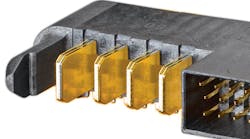As product designers demand more from their components, connector suppliers are stepping up with new solutions that marry the tried-and-true qualities of reliability and performance with the need for greater speed, more flexibility, and intuitiveness. Indeed, today’s connector solutions are smarter than you think—and designed to fit a wide range of growing market demands.
For a pointed example, look no further than the December announcement from the Rochester Institute of Technology and PPC Corp. about their “Smart Connector,” a sensor that detects and pinpoints damage in cellular cables, potentially saving telecommunications companies millions of dollars in maintenance, repair, and upgrade costs. The technology enables companies to monitor cable connections in real time and conduct maintenance preventively rather than reactively, once a piece of equipment has failed.
The development answers the call for intelligence and feedback that can help reduce maintenance costs and improve productivity and efficiency in a wide range of industries. Though the RTI/PPC smart connector is designed for radio-frequency cable interconnects, the technology could have far-reaching capabilities.
“Beyond cellular connectors, it is easy to imagine this technology finding a place in other high-value or ‘can’t fail’ applications such as communications or internal networks in spacecraft or aircraft. I look forward to uncovering all the possibilities,” Robert Bowman, professor of electrical and microelectronic engineering in RIT’s Kate Gleason College of Engineering, told the RIT University News in December.
Still other advances are addressing the need for smaller size, higher speeds, and greater flexibility. For example, a host of solutions on display at last month’s DesignCon 2012 Expo aimed to showcase products that help designers develop faster, smarter, and more innovative connections.
SFF 8643 Mini Multilane Internal Cable Assemblies
FCI and 3M announced the availability of the SFF 8643 Mini Multilane Internal Cable Assemblies for SAS HD connections from FCI, featuring the high-performance Twin Axial Cable SL8800 series from 3M. SFF 8643 assemblies support the SAS 2.1 standard at 6 Gbits/s and are expected to fully comply with the upcoming SAS 3.0 specification, which will increase the data rate up to 12 Gbits/s. These cable assemblies are ideal for system applications requiring high-density routing in tight spaces or where restricted airflow is a concern.
“The twin axial cable from 3M allows FCI to offer mini SAS HD internal cable assemblies that deliver excellent electrical performance to the defined SAS 2.1 and proposed SAS 3.0 industry standards. The cable’s mechanical advantages also allow FCI the ability to offer cables that can be bent at a 90° angle during routing without any signal degradation,” noted Jim David, global product manager, FCI.
EXTreme Power Interconnects
Molex’s EXTreme Power products offer high-current interconnect solutions with best-in-class power densities. The lineup ranges from the EXTreme Micro-Power 16.0A blades to EXTreme Power-Mass 150.0A modules (Fig. 1).
The need for high-current power interconnect solutions in increasingly smaller space continues to rise rapidly, and solving this power equation on new architectures and system platforms has been a major focus for Molex product development teams, the company said.
Since no two applications are the same, the Molex EXTreme Power line comprises several product families that cover a wide range of current levels, mechanical envelopes, mating terminations, and configuration choices, enabling system designers to maximize their power interconnect needs.
STRADA Connectors
TE Connectivity’s STRADA Mesa Connector system is the latest advance for mezzanine (stacking) applications (Fig. 2). Its pin and socket signal contact design can be arranged in high-speed differential, high-density single-ended, and/or coax patterns. In addition, the STRADA Mesa connector offers integrated power contacts, each capable of carrying 14 A.
The STRADA Mesa system is being offered in stack height options starting at 8 mm and growing to 42 mm. It’s also offered in standard width, which has eight differential pairs per column, and half width, which has four differential pairs per column.
Standard width, with eight pairs per column, is offered in sizes 1, 2, and 3, which when fully loaded with differential pairs will yield 40, 80, and 120 pairs, respectively. Half width, four pairs per column, is also offered in sizes 1, 2, and 3, which, when fully loaded with differential pairs, will yield 24, 48, and 88 pairs, respectively.








